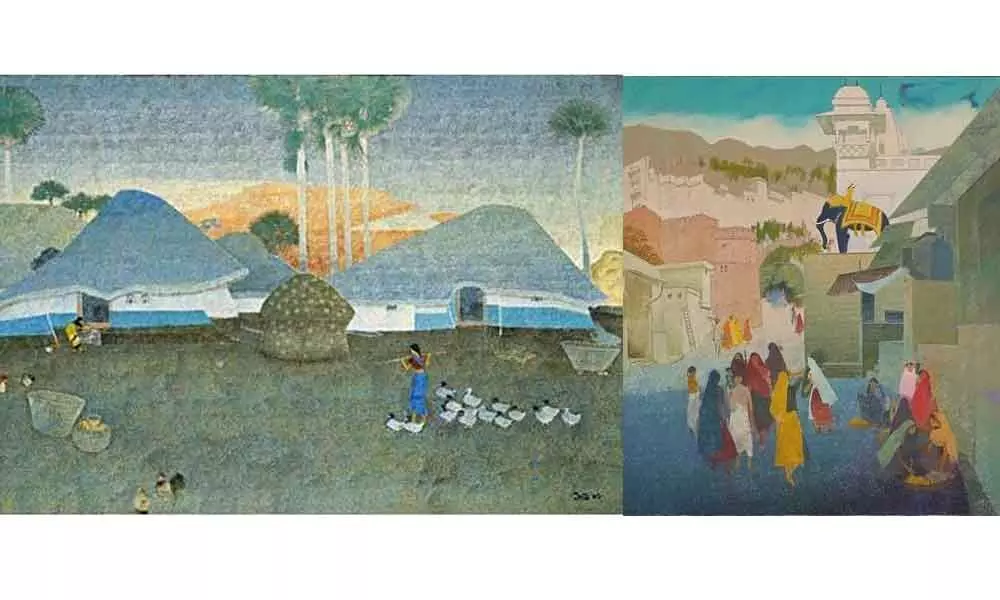Is N S Bendre finally getting his due?
The Indore-born artist was not just a seminal modern master of Indian art but groomed an entire generation of future stalwarts
image for illustrative purpose

Even as we wait for the new year's big ticket Indian auctions to take place in the spring season - often in March in London and New York by Christie's and Sotheby's, and in April by Saffronart in Mumbai - it is worthwhile to continue our talk on the newer names that have begun to come under the flood lights at the very top in the previous few sales of Indian art. It has been heartening to see the market expand its arc and include hitherto ignored but deserving masters to give them their due.
In a previous column, we looked at the case of Bhupen Khakhar, the trailblazing artist whose works are now beginning to feature alongside eternal market favourites such as S H Raza, F N Souza, M F Husain, and V S Gaitonde, setting a personal record for the artist, though yet to achieve a record for Indian art. By the looks of it, Khakhar's works will get there pretty soon.
Another name that has been slowly scaling up the charts on the market and finding increasing favour with the collectors is that of N S Bendre.
Bendre at 2021 auctions
At Astaguru's Modern Indian Art auction on 27-28 December, an Untitled oil on canvas by Bendre from 1980 was estimated at Rs 1.5-2 crore. After an eager interest in the work by buyers, it eventually fetched a whopping Rs 6 crore.
At Pundole's live auction in Mumbai on 18 November, titled The Fine Art Sale, Bendre's 1979 oil on canvas work, Jaisalmer Fort, a mélange of colours of the sunny Rajasthan monument, had a stunning rally. Estimated at Rs 60 lakh to Rs 80 lakh, it was sold for Rs 5 crore. Three more of his works went upwards of a crore at this auction: Kashmir Landscape (Rs 3.8 crore), A Bundi House (Rs 3.5 crore) and Tarnetar Fair (Rs 3.2 crore).
Elsewhere too, his works notched up a crore plus. At Saffronart's Summer Live Auction on 13 July, his Untitled oil on canvas from 1985, showing a village scene at the crack of dawn, went for $228,000 or Rs 1.67 crore while at the Christie's South Asian Modern + Contemporary Art auction on 22 September in New York, his 1972 oil on canvas, Untitled (Three Women), a delightful portrait of three young village belles, was sold for $225,000 (approx. Rs 1.6 crore).
All these sales are a great nod from the market for the artist who should have been in this price bracket long ago, not just for the brilliance of his art but also for the seminal role he played in shaping an entire generation of Indian artists.
All these auction results underscore an important emerging reality - that the collectors are finally beginning to see the worth of N S Bendre's art, enough to put faith and big bucks behind it. All the works were from different decades of the artist's career and explored different imageries yet bearing a distinct Bendre stamp of lyricism in the depiction of subjects.
Who is N S Bendre?
The name Narayan Shridhar Bendre (1910-1992) is not likely to ring a bell beyond the confines of the serious community of art practitioners, collectors and admirers. And that's the pity.
N S Bendre was born on 21 August 1910 in Indore and studied at Dattaray Deolalikar's art school at Chitrakala Mandir in his hometown. He obtained a diploma in painting from the School of Art, Indore, and at the age of 30, joined a production company in Madras as an art director. However, it was his US tour in 1947-48 that brought him vital exposure to western contemporary art trends and decidedly influenced his vocabulary in the decades to come.
While in the US, Bendre learnt graphic art at the art students league in New York. He returned to India to join the prestigious M S University, Baroda, where he served as the head of the painting department from 1950-59, eventually retiring as the dean of the university in 1966.
Bendre is remembered for his paintings across genres - figurative, landscapes, abstractions - and in a variety of styles, from academic realism to 'en plein air' (painted on site) impressionism and pointillism (in which small, distinct dots of colour help create an image). Through all this varied imagery, Bendre managed to imbue his paintings with a certain mood, which make his works unique as well as endearing at the same time.
In fact, his watercolour landscapes remain some of the most charming works, which he painted prolifically on his numerous travels.
However, Bendre's most seminal contribution to collective Indian art remains in his grooming of the important Baroda Group of Artists.
Formed in 1956 under his guidance, the group comprised young artists who would go on to become luminaries of the Indian art scene in the later years, such as Bhupen Khakhar, Gulammohammed Sheikh, Rekha Rodwittiya, Vivan Sundaram, among others. Besides impacting the art of his students in a fundamental manner, his years in Baroda were fruitful for him professionally too as during this time, he indulged in successful experimentations in his painting.
The renewed interest in Bendre's art in recent times has seen two important exhibitions on his work - while Emami Art held a month-long exhibition of his drawings, sketches and watercolours in November-December last year in Kolkata, Vadehra Art Gallery in New Delhi showed his watercolours from 16 December 2021 to 12 January this year.
A strong museum retrospective, if possible, would accentuate the highly desirable academic value of his art, and catapult his prices further. The market is just opening for N S Bendre's art.
(The writer is a New Delhi-based editor, writer and arts consultant. She blogs at www.archanakhareghose.com )

